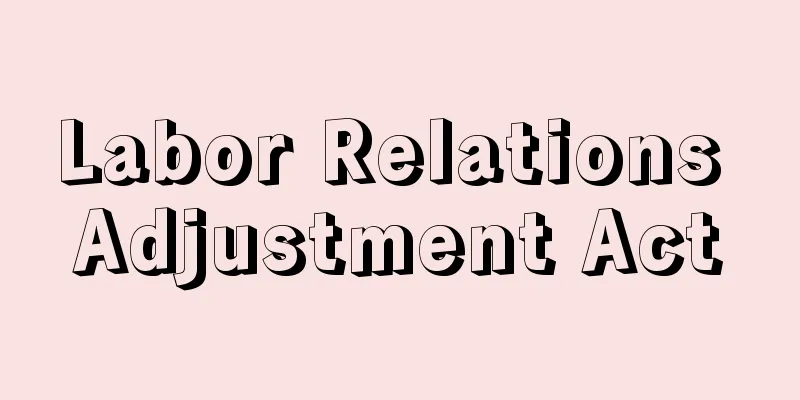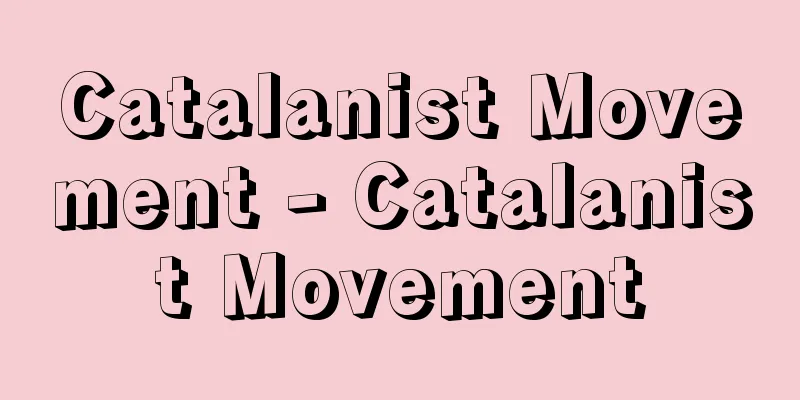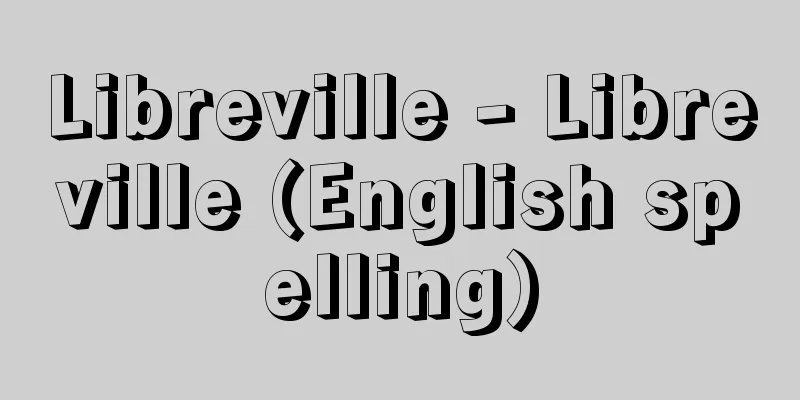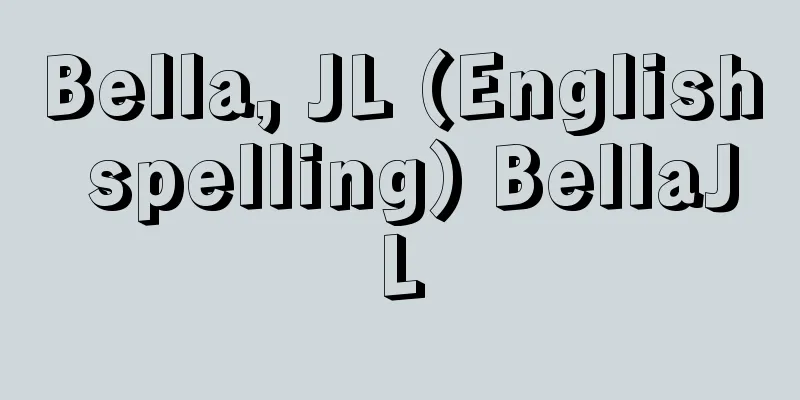Labor Relations Adjustment Act

|
This law provides for the resolution of disputes in labor-management relations. Law No. 25 of 1946. Abbreviated as Labor Adjustment Law. HistoryBefore the Second World War, the Labor Dispute Conciliation Law was enacted in April 1926 (Taisho 15) as a law on labor disputes. This law was not intended to resolve labor-management disputes, but was rather used to suppress labor disputes by state power, and had a strong secular law color. There were few cases in which this law was actually applied, and the main method of resolving labor-management disputes before the war was the suppression of labor disputes by police power, known as "sabre conciliation." After the war, the old Labor Union Law was enacted in December 1945 (Showa 20), aiming to liberate and support the labor movement. Reflecting the economic situation at the time, many labor disputes occurred, and in 1946, the same Diet that enacted the Constitution of Japan, the old Labor Relations Adjustment Law was enacted and came into effect on October 13 of the same year. The old Labor Adjustment Law included a system of advance notice of disputes in public utilities and a prohibition on labor disputes by non-operational public servants, but these provisions were later stipulated in the Public Servant Law and other laws. The old Labor Adjustment Act was subsequently revised in June 1949, and further revised in July 1952 to establish the emergency adjustment system, resulting in the current law. [Hiroshi Murashita and Mikio Yoshida] ContentsThe current law is composed of chapters on general provisions, mediation, conciliation, arbitration, emergency adjustment, and restrictions on and prohibitions against dispute actions. These can be broadly divided into sections on dispute adjustment and restrictions on dispute actions. The purpose of the Labor Adjustment Law is "to promote fair adjustment of labor relations, prevent or resolve labor disputes, maintain industrial peace, and thereby contribute to economic prosperity, in conjunction with the Labor Union Law" (Article 1). The adjustment of labor disputes referred to here is, in principle, first of all, to a voluntary settlement between the parties involved, and if a disagreement arises between the parties' claims, the state power (government) will assist in the voluntary settlement and prevent dispute actions (Articles 2-4). The reason why labor dispute adjustment is, in principle, left to the parties' voluntary resolution is that if the state power intervenes in labor-management disputes with force, it will not be a true dispute resolution. The Labor Adjustment Law prescribes mediation, conciliation, arbitration, and emergency adjustment as methods of dispute adjustment, while the principle is voluntary resolution between labor and management. Mediation is carried out by a mediator (Article 10 onwards), and conciliation is carried out by a conciliation committee (Article 17 onwards), but neither method is binding on the labor and management parties. Arbitration has the same effect as a labor agreement and is binding on both labor and management (Article 29 onwards). Furthermore, the emergency adjustment system is exceptional and unique both in terms of the history of its introduction and in terms of the principles of labor dispute adjustment. Emergency adjustment is decided by the Prime Minister after hearing the opinion of the Central Labor Relations Commission only when there is a risk of disruption to the operation of the national economy or endangering the lives of the people due to "the case being related to a public utility business, or because it is large in scale, or because it is related to a business of a special nature" (Article 35-2, Paragraph 1). The restrictions and prohibitions on labor disputes under the LLACA include notice of labor disputes in public works (Article 37), the prohibition of labor disputes during emergency adjustment (Article 38), restrictions on labor disputes after the acceptance of a mediation proposal (Article 26), and the prohibition of labor disputes involving the suspension or abolition of safety facilities (Article 36). Note that the LLACA does not apply to labor disputes and labor disputes involving public servants, which are covered by the Law Concerning Labor Relations of Administrative Execution Corporations and the Local Public Enterprise Labor Relations Law, etc. [Hiroshi Murashita and Mikio Yoshida] "Nomura Heiji and Nakayama Kazuhisa, Legal Studies Collection 48: Labor Relations Adjustment Law, New Edition (1987, Yuhikaku)" ▽ "Manabe Takanori and Nishitani Satoshi eds., Labor Law 1: Collective Labor Relations Law, 3rd Edition (2006, Horitsu Bunkasha)" ▽ "Ministry of Health, Labor and Welfare ed., Labor Union Law and Labor Relations Adjustment Law, 5th Revised Edition (2006, Labor Administration)" [Reference] | | | | | |Source: Shogakukan Encyclopedia Nipponica About Encyclopedia Nipponica Information | Legend |
|
労使関係における紛争処理について定めた法律。昭和21年法律第25号。略称、労調法。 沿革第二次世界大戦前には労働争議に関する法律として、1926年(大正15)4月制定の労働争議調停法がある。同法は、労使紛争を解決することを目的とするものではなく、むしろ労働争議を国家権力によって弾圧することに利用され、治安立法的色彩が強かった。実際に同法が適用されたケースは少なく、戦前におけるおもな労使紛争解決手段は、「サーベル調停」とよばれる警察力による労働争議の弾圧であった。戦後の1945年(昭和20)12月に旧労働組合法が制定され、労働運動の解放と助成が図られた。当時の経済状況を反映して多くの労働争議が発生し、1946年日本国憲法が制定された同じ国会において、旧労働関係調整法が制定され、同年10月13日から施行された。旧労調法には、公益事業の争議予告制度、非現業公務員の争議行為禁止などが含まれていたが、のちにそれらの規定は公務員法などで定められることとなった。旧労調法はその後1949年6月に改正され、さらに1952年7月の緊急調整制度を新設するための改正を経て、現行法に至っている。 [村下 博・吉田美喜夫] 内容現行法は、総則、斡旋(あっせん)、調停、仲裁、緊急調整、争議行為の制限禁止等の各章から構成されている。これらを大別すれば、争議調整と争議行為の制約からなっている。労調法の目的は、「労働組合法と相俟(ま)つて、労働関係の公正な調整を図り、労働争議を予防し、又は解決して、産業の平和を維持し、もつて経済の興隆に寄与すること」(1条)にある。ここでいう労働争議の調整は、まず原則として当事者間における自主的解決を図り、もし当事者間の主張に不一致が生じた場合には国家権力(政府)が自主的調整を助成して争議行為を防止するものとされている(2~4条)。労働争議の調整が原則として当事者の自主的解決にゆだねられているのは、国家権力が労使紛争に強権的に介入すると、かえって真の紛争解決とならないからである。 ところで労調法は、争議調整方法として、労使の自主的解決を原則としつつ、斡旋、調停、仲裁、緊急調整を規定している。斡旋は斡旋員によって行われ(10条以下)、調停は調停委員会によって行われる(17条以下)が、両者とも労使の当事者を拘束することはない。仲裁は、その裁定が労働協約と同一の効力を有しており、労使双方を拘束するものである(29条以下)。さらに緊急調整制度は、この制度の導入の経緯からしても、また労働争議調整の原則からしても例外的かつ特殊なものである。緊急調整は、「事件が公益事業に関するものであるため、又はその規模が大きいため若(も)しくは特別の性質の事業に関するものであるために」(35条の2第1項)、争議行為によって国民経済の運行の阻害または国民生活を危うくするおそれがある場合に限って、内閣総理大臣が中央労働委員会の意見を聞いて決定するものである。 労調法による争議行為の制限禁止は、公益事業における争議行為の予告(37条)、緊急調整の際の争議行為の禁止(38条)、調停案受諾後の争議行為の制限(26条)、安全保持施設の停廃を伴う争議行為の禁止(36条)などである。なお、労調法は公務員労働者の労働争議および争議行為には適用されず、それらには行政執行法人の労働関係に関する法律、地方公営企業労働関係法などが適用される。 [村下 博・吉田美喜夫] 『野村平爾・中山和久著『法律学全集48 労働関係調整法』新版(1987・有斐閣)』▽『萬井隆令・西谷敏編『労働法1――集団的労働関係法』第3版(2006・法律文化社)』▽『厚生労働省編『労働組合法・労働関係調整法』5訂新版(2006・労務行政)』 [参照項目] | | | | | |出典 小学館 日本大百科全書(ニッポニカ)日本大百科全書(ニッポニカ)について 情報 | 凡例 |
>>: Working environment - Roudoukankyo (English) working environment
Recommend
Sugen-in Temple
Tokugawa Hidetada's wife. Mother of Iemitsu. ...
Myristyl Alcohol
Chemical formula: CH 3 (CH 2 ) 13 OH. Also known a...
Willigermus - Willigermus
…The upper exterior is surrounded by a gallery wi...
Katsunō Shin
1821-1886 A Kabuki composer from the late Edo to ...
Bolboschoenus paludosus (English spelling) Bolboschoenuspaludosus
…[Tetsuo Koyama]. … *Some of the terminology that...
National Restoration Party
Founded in January 1932 by Yasuoka Masaatsu of Kin...
Gondo Seikei
Born: March 21, 1868, Kurume [Died] July 9, 1937. ...
feature film
...It is also called a programmer in English. In ...
Cough - Gaisou (English spelling) cough
Coughing refers to the phenomenon in which air fro...
Asturrabī (English spelling) al‐Asṭurlābī
An Arabian astronomer in the first half of the 9th...
Treasures of Hildesheim - How to Know Hildesheim
A collective name for 62 pieces of silver tablewar...
Yoshii Isamu
Poet, playwright, novelist. Born on October 8, 18...
Oceanus Britannicus (English spelling)
…Its width gradually narrows from about 180 km in...
"School of Athens" - Atene no Gakuen
In 1508, he was invited by Pope Julius II to Rome...
Ninnaji Temple
Located in Omuro Ouchi-cho, Ukyo-ku, Kyoto City, ...









